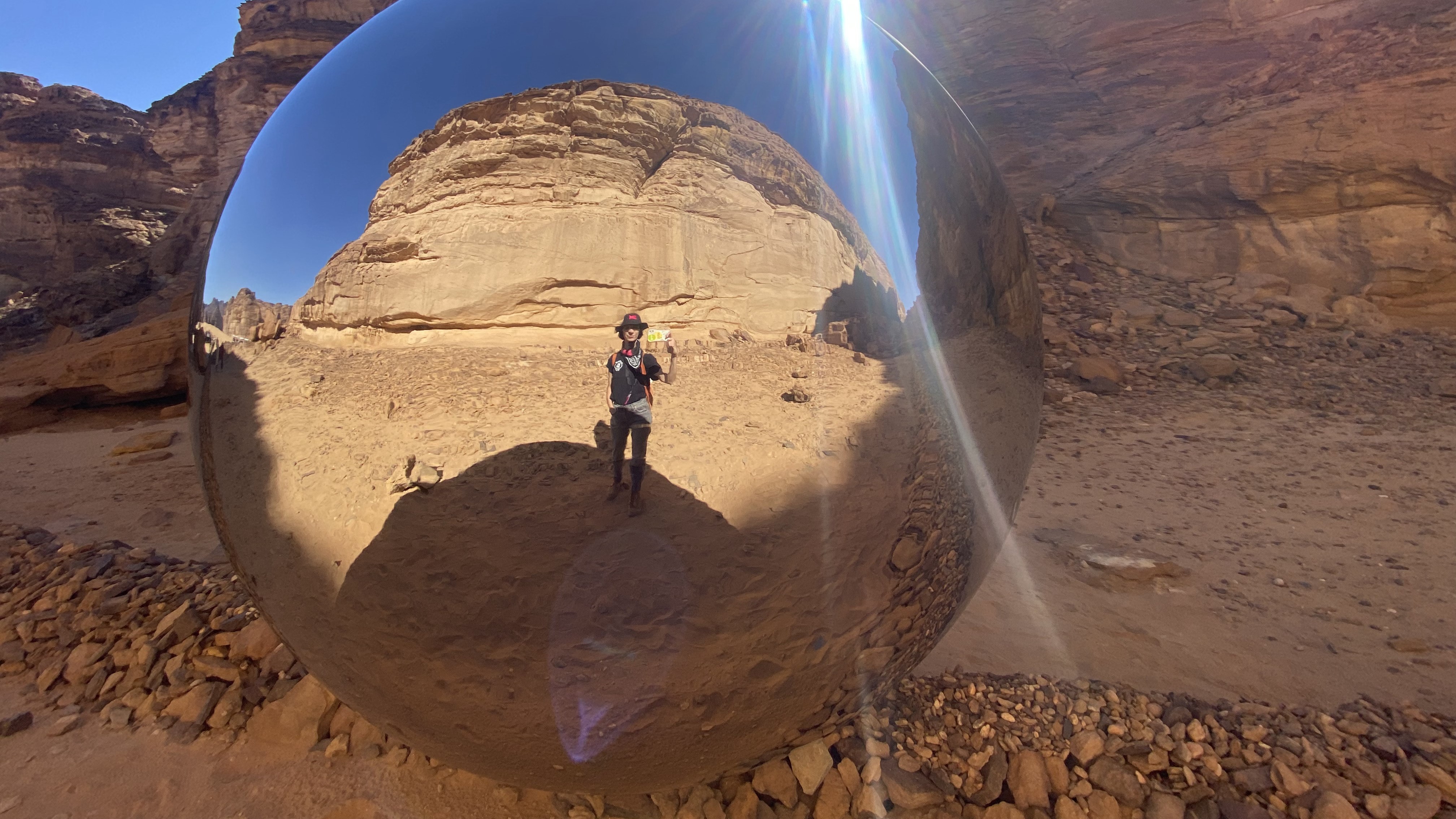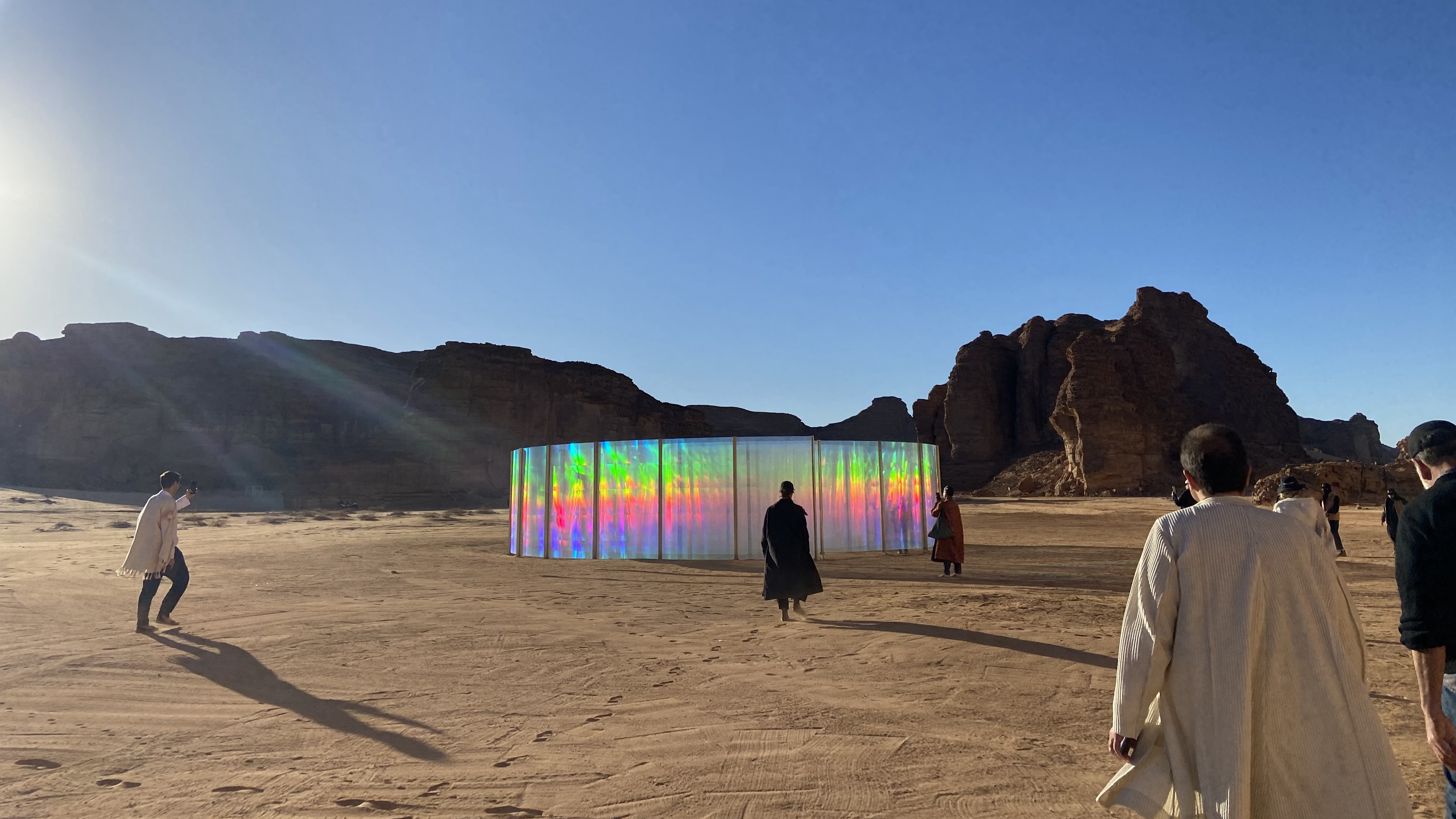"The desert is demanding new ways of seeing"

Breathtaking desert landscapes, imponent natural rock formations, and in the midst of them, large artworks in stark colours and shapes. The art-in-the-landscape Desert X AlUla, staged in Saudi Arabia, had more than enough to satisfy everyone's wildest desert fantasies. For its third edition, from 9 February to 23 March, the American-branded exhibition presented a series of highly evocative site-specific installations in the Wadi Al Fann desert.
"This is an area of the world that was relatively empty for a very long time, so we haven't interpreted it artistically," says Marcelo Dantas, co-curator of Desert X with Maya El Khalil. "I would say that in any city in the world, any one of these mountains would be iconic, and here we have hundreds of them."
The theme chosen by the two curators was "In the Presence of Absence", which managed to achieve a balance between international, Saudi and regional artists. "Our aim was really to curate the desert and all it contains," says Khalil. "It's a landscape-centric rather than a human-centric perspective, which makes it impossible to use language."
Khalil says that the artists invited have struggled to put up with the monumentality of the desert: "Human perceptions fall short when we think of the time-scale and the forces that have shaped this landscape. These forces are inconceivable for us humans. The desert is demanding new ways of seeing."
An example of this is the work of Caline Aoun, who addressed "the question of what cannot be seen", as she puts it. Through the minimal intervention of polishing the stones on the ground, she created a lighter circle of stone: "I wanted to stay true to the landscape and to me polishing is an act of protection."
Desert X director, British curator Neville Wakefield sees this new rounds of commission in AlUla as a new chapter of history for regional art, to be expanded for years to come: "Our vision is to become the world's most iconic festival for arts in the landscape," he says.
The director is acutely aware of the commitment of the Saudi government to a complete change of image. In the past three years in fact the country – which had been closed to tourism up until the pandemic – has been heavily investing in the arts.

An entire makeover
The only thing more attractive than a desert fantasy is a life makeover, and this is precisely what Saudi Arabia is going through. However, rather than a "change your life in six months" YouTube challenge for individuals hungry for self-development, this is a "change the entire economy of the country in 10 years".
Indeed, Crown Prince Mohammed bin Salman's ambitious project is called "Vision 2030" launched in April 2016, as a strategic plan to achieve three intertwined goals: diversifying the Saudi economy away from oil, modernising the society at par with cultural traditions and enhancing the Kingdom's global profile.
The cultural industries are among the ones being most affected by this change: Desert X AlUla is at the heart of the storm, along with several other events that are happening in concurrence; a sculpture festival, the Diriyah Biennale near Riyadh, an Islamic Biennale that will happen next year in Jeddah, and several big and small initiatives punctuating the Saudi arts and culture calendar.
"Since the beginning in 2020, Desert X has played a key role in highlighting AlUla as an established and respected arts venue, carefully building local and international audiences over the last few years," says Susan Davis, the founder of Desert X, which was initiated in Coachella in the United States. "We are providing an unparalleled opportunity to experience contemporary art in dialogue and collaboration with nature."

Controversies around the first edition
While the Desert X first launched in the Coachella Valley in California in 2017, its first Saudi iteration generated controversies from the outset. The event met with strong criticism from the international press and was boycotted by much of the international art community.
Concerns about human rights, freedom of expression and the general Saudi political context saw the resignation in 2019 of three of the 14 members of Desert X's board of directors, namely artist Ed Ruscha, art historian Yael Lipschutz and stylist Tristan Milanovich. Three years later, however, the festival has garnered almost complete consensus from the international art world.
Rebecca Ann Proctor, author of the book "Art in Saudi Arabia: A New Creative Economy?" found the latest edition to be free of polemics: "The first edition was extremely problematic, the international art community boycotted the event, and Saudi artists pointed out that they were not propaganda machines," she notes. "The second edition was already much calmer, with international press joining in, and in this third edition I didn't hear of any controversy at all."
She even spotted journalists from magazines that previously had a policy of not covering Saudi Arabia: "There's been a huge shift, over the last few years. People were really sceptical, but now they are coming and engaging with the country."
To Proctor, this is mainly due to the number of cultural activities in the Kingdom: "It's crucial to the Saudi strategy that they are not just focusing on elevating the work of Saudi artists and the Saudi population through art and culture," she says. "They are also giving a space to bring international artists to Saudi Arabia. So there's real cross-cultural dialogue. And I think that is what has contributed to the change."
Finally, we can see how the international art community is starting to view Saudi Arabia as the land of infinite possibilities. Of course, within the confines of what is culturally possible in a country that decisively doesn't align in terms of laws, rights and culture with the West, but is very much interested in participating in its art economy.
It is precisely Saudi Arabia's desire to enter the global economy and the art system that could encourage these unacceptable behaviours and practices to disappear in the country. On the other hand, the Western art world is accepting compromises, hopeful the country will increasingly align with humanistic values.
"In an art world starved of funding, it's only natural that the world would turn to the only one who still believes that art can make a change," says a visitor. "Saudis are now correcting their step, and culture is changing their way of looking at the world, opening their perspectives."
Some local artists are keenly aware of the gap there is between Saudi Arabia only a few years ago, and the country today. Although the artworks at Desert X don't address that, artists are all inevitably informed by this totally new experience of their own country and unprecedented openness.
"Growing up in 'previous Saudi', we heard a lot of stories about djinn, a mythological creature that inhabited desertic areas like Al-Ula, and could take the form of a snake," says Filwa Nazer from Jeddah, standing in front of her work, a bridge in the middle of nowhere, inspired by the body of a petrified skeleton of a snake.
"Approaching the bridge/snake, I hoped visitors would feel like they were walking through a journey of shadows," concludes the artist. "It's a metaphor for overcoming the dark journey."
© Qantara.de 2024